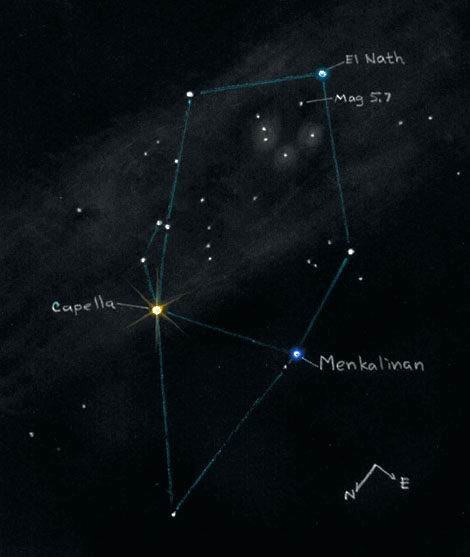
Observation Notes:
Once some high cirrus clouds cleared out, Auriga materialized in detail as a pentagon shape. The northwest star, Capella, was the brightest, colored yellow-orange. El Nath, in the south, appeared cyan, while Menkalinan looked blue. The Milky Way's soft light flowed west-northwest to east-southeast along the southwestern half of the constellation. Just north of El Nath, three areas looked like unresolvable star clouds as indicated in the sketch.
The dimmest star I sketched was Mag. 5.69--SAO58040--north of El Nath. Auriga is home to 3 big Messier open clusters, M36, M37 and M38, as well as a number of other smaller open clusters. Near M38 are two big asterisms I enjoy seeing in binoculars: The Smiley Face, popularized--as far as I know--by Carol L. at CloudyNights.com, and a Grrr Face I noticed just above it. Those asterisms account for two of the star clouds I noticed and scrubbed into the sketch.
| Subject | Auriga |
| Classification | Constellation |
| Date/Time | January 28, 2005 - 08:45 PM MST (January 29, 2005 - 03:45 UT) |
| Observing Loc. | Flagstaff, AZ - Home [111°39' Long / 35°12' Lat] |
| Instrument | Naked eye |
| Eyepieces/Mag. | N/A |
| Conditions | P.Cloudy, 36°F |
| Seeing | ~3/10 |
| Transparency | Mag 5.7 (Based on SAO58040 in Auriga) |





Jeremy,
Congratulations on showing how astronomical objects actually look through the eyepiece! Your sketches/drawings are inspiring.
I was pointed to your site by my friend Peter ('Top of the Lawn') as we were talking about the Auriga asterism mentioned in this post.
It's true that 'smiley face' has been popularized nicely by Carol.
In case you're interested here is a post I wrote about discovering this asterism while hunting around Auriga for the Messier open clusters. In the blog entry I reference the original Yahoo! group posting where I asked if this asterism had already been discovered and what it's name was and no one was able to point me to an original source.
Here is a link about the discovery of the Cheshire Cat which we at TotL make reference to every now and then. Tonight we used it to star hop to a close double in Auriga STF 644.
Thanks again reproducing your excellent sketches and for keeping this website in such good shape.
Ben
Hi Ben, thanks very much!
I remember the references you posted at CloudyNights.com regarding the Cheshire Cat around a year ago. By that time, I had forgotten I even mentioned the asterism in this constellation post and never came back to update it. We actually had a discussion about it last month. Steve Coe, with the Saguaro Astronomy Club was putting together an observing list of asterisms on the downloads page of their club website. I don't know if you've ever checked out their site, but they have a top notch set of observing lists there.
Peter has got an outstanding astro site too. The amateur astronomy you guys do in New York City is inspiring. I hadn't been to your site in a while, and just noticed the excellent set of bird photos and observations. The Red Hawk photo is a real beauty. Very nicely done!
Jeremy
Jeremy,
Thanks for the follow-up. When I searched for this page I couldn't see the comments until I clicked 'preview'. I was wondering if this is the way it should be working.
Thanks for the link to the recent discussion concerning asterisms at Cloudy Nights. I hadn't realized this thread existed.
The reason Peter and I were talking about the Cheshire Cat was because of Steve Coe's SAC listing of asterisms. It was good to see the Cheshire Cat made it on the list and I mentioned that it was listed it with the highly generic 'smiley face'. Cheshire Cat has a bit of a nicer ring to it and I like the alliterative quality too.
Thanks for your comments on the blog. That photo of the one year old Red-tailed Hawk was particularly special since it shows the red tail with 2 juvenile feathers (one is visible in the photo). This only happens with a one year old hawk. At two years old the tail will be completly red.
All the best.
omg!!!!!
Have you thought of a mystic creature to represent the constellation yet?
Hi Alfred, Auriga has always made me think of a huge gemstone with an extra little nodule on one facet. Historically, it's been associated with the "Charioteer".